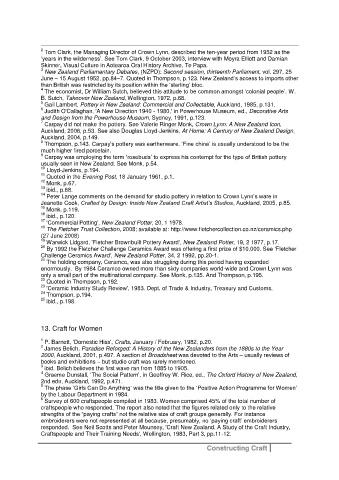Page 317 - Constructing Craft
P. 317
2
Tom Clark, the Managing Director of Crown Lynn, described the ten-year period from 1952 as the
‘years in the wilderness’. See Tom Clark, 9 October 2003, interview with Moyra Elliott and Damian
Skinner, Visual Culture in Aotearoa Oral History Archive, Te Papa.
3
New Zealand Parliamentary Debates, (NZPD): Second session, thirteenth Parliament, vol. 297, 25
June – 15 August 1952, pp.84–7. Quoted in Thompson, p.123. New Zealand’s access to imports other
than British was restricted by its position within the ‘sterling’ bloc.
4
The economist, Dr William Sutch, believed this attitude to be common amongst ‘colonial people’. W.
B. Sutch, Takeover New Zealand, Wellington, 1972, p.68.
5 Gail Lambert, Pottery in New Zealand: Commercial and Collectable, Auckland, 1985, p.131.
6
Judith O'Callaghan, 'A New Direction 1940 - 1980,' in Powerhouse Museum, ed., Decorative Arts
and Design from the Powerhouse Museum, Sydney, 1991, p.123.
7
Carpay did not make the pottery. See Valerie Ringer Monk, Crown Lynn: A New Zealand Icon,
Auckland, 2006, p.53. See also Douglas Lloyd-Jenkins, At Home: A Century of New Zealand Design,
Auckland, 2004, p.149.
8
Thompson, p.143. Carpay’s pottery was earthenware. ‘Fine china’ is usually understood to be the
much higher fired porcelain.
9
Carpay was employing the term ‘rosebuds’ to express his contempt for the type of British pottery
usually seen in New Zealand. See Monk, p.54.
10 Lloyd-Jenkins, p.194.
11
Quoted in the Evening Post, 18 January 1961, p.1.
12 Monk, p.67.
13
ibid., p.68.
14
Peter Lange comments on the demand for studio pottery in relation to Crown Lynn’s ware in
Jeanette Cook, Crafted by Design: Inside New Zealand Craft Artist’s Studios, Auckland, 2005, p.85.
15 Monk, p.119.
16
ibid., p.120.
17 'Commercial Potting', New Zealand Potter, 20, 1 1978.
18
The Fletcher Trust Collection, 2008; available at: http://www.fletchercollection.co.nz/ceramics.php
(27 June 2008)
19
Warwick Lidgard, 'Fletcher Brownbuilt Pottery Award', New Zealand Potter, 19, 2 1977, p.17.
20
By 1992 the Fletcher Challenge Ceramics Award was offering a first prize of $10,000. See 'Fletcher
Challenge Ceramics Award', New Zealand Potter, 34, 2 1992, pp.20-1.
21
The holding company, Ceramco, was also struggling during this period having expanded
enormously. By 1984 Ceramco owned more than sixty companies world-wide and Crown Lynn was
only a small part of the multinational company. See Monk, p.135. And Thompson, p.195.
22
Quoted in Thompson, p.192.
23
'Ceramic Industry Study Review', 1983. Dept. of Trade & Industry, Treasury and Customs.
24
Thompson, p.194.
25
ibid., p.198.
13. Craft for Women
1
P. Barnett, 'Domestic Hiss', Crafts, January / February, 1982, p.20.
2
James Belich, Paradise Reforged: A History of the New Zealanders from the 1880s to the Year
2000, Auckland, 2001, p.497. A section of Broadsheet was devoted to the Arts – usually reviews of
books and exhibitions – but studio craft was rarely mentioned.
3
ibid. Belich believes the first wave ran from 1885 to 1905.
4
Graeme Dunstall, ‘The Social Pattern’, in Geoffrey W. Rice, ed., The Oxford History of New Zealand,
2nd edn, Auckland, 1992, p.471.
5
The phase ‘Girls Can Do Anything’ was the title given to the ‘Positive Action Programme for Women’
by the Labour Department in 1984.
6
Survey of 600 craftspeople compiled in 1983. Women comprised 45% of the total number of
craftspeople who responded. The report also noted that the figures related only to the relative
strengths of the “paying crafts” not the relative size of craft groups generally. For instance
embroiderers were not represented at all because, presumably, no ‘paying craft’ embroiderers
responded. See Neil Scotts and Peter Mounsey, 'Craft New Zealand. A Study of the Craft Industry,
Craftspeople and Their Training Needs', Wellington, 1983, Part 3, pp.11-12.
Constructing Craft

